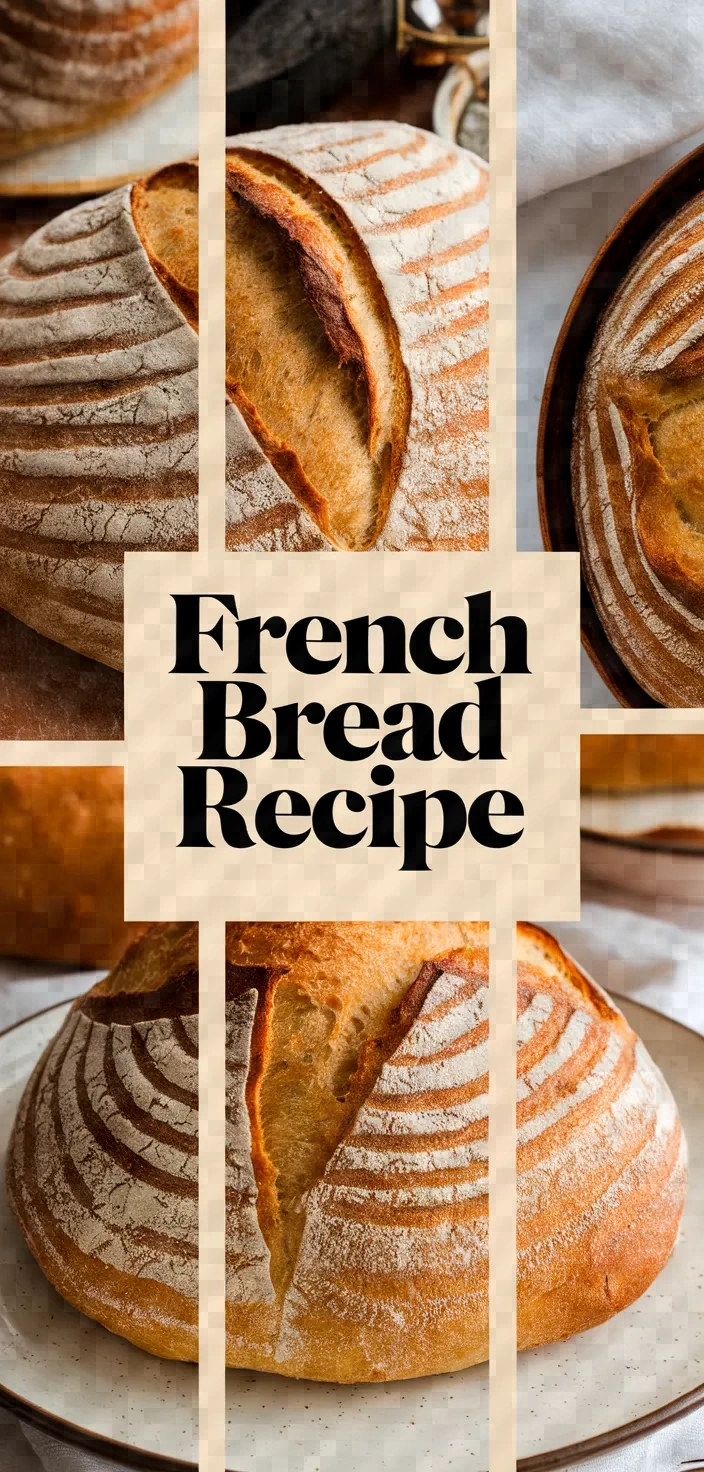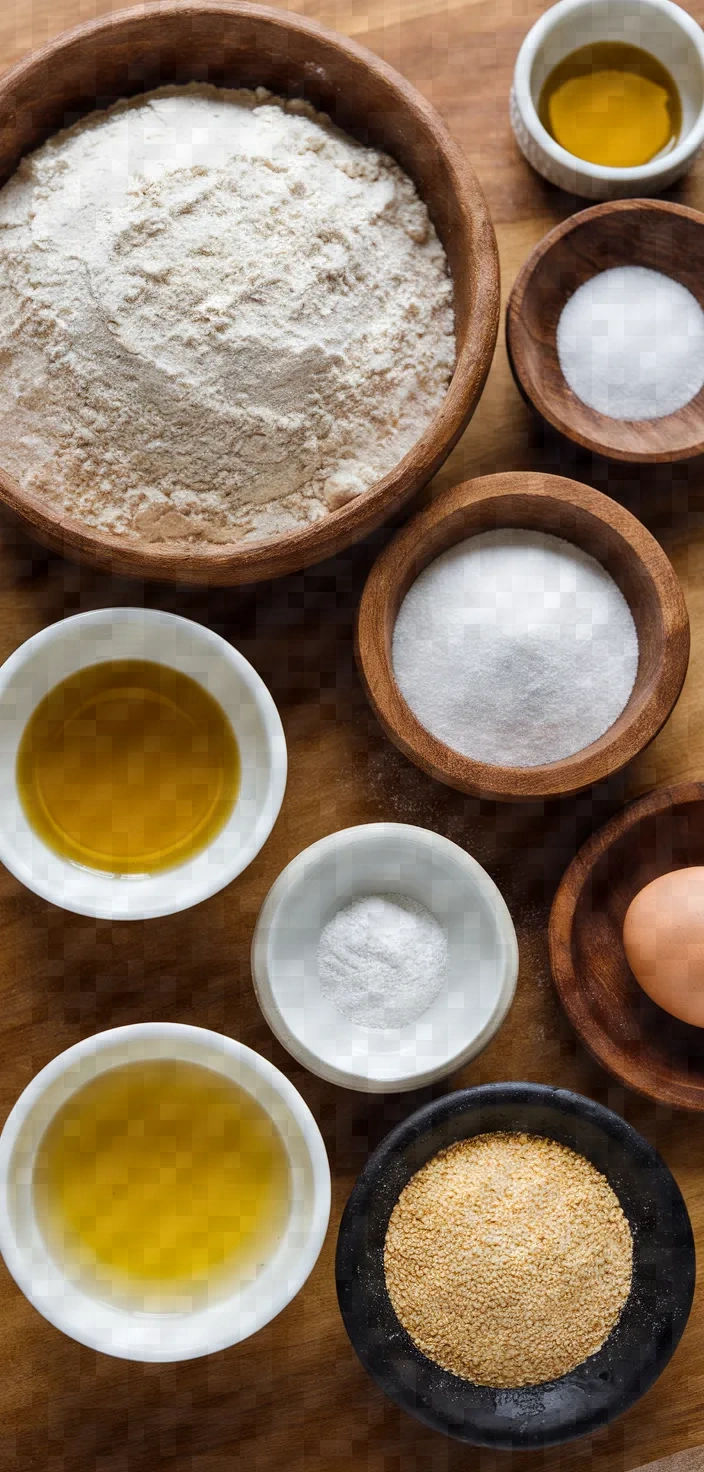There’s something profoundly satisfying about watching a simple mix of flour, water, and a pinch of creativity transform into a golden, crusty loaf of bread in your very own kitchen. Join me on this cozy baking adventure as we dive into crafting homemade bread that promises to fill your home with warmth and the irresistible scent of freshly baked goodness!

I love the simplicity of French bread that combines all-purpose flour, a touch of sugar, and warm water into a deliciously crusty loaf. The olive oil adds a subtle richness while the yeast and salt bring out the classic flavor.
Dusting with cornmeal and an egg white glaze creates a perfect finish.
French Bread Recipe Ingredients

- All-purpose flour: Rich in carbohydrates; provides structure to the bread.
- Sugar: Feeds the yeast; gives a subtle sweetness.
- Salt: Enhances flavor; regulates yeast activity.
- Instant yeast: Leavening agent; makes the bread rise.
- Warm water: Activates yeast; crucial for dough hydration.
- Olive oil: Adds moisture; contributes healthy fats.
- Cornmeal: Used for dusting; prevents sticking, adds texture.
- Egg white: Provides glaze; gives a shiny, crisp crust.
French Bread Recipe Ingredient Quantities
- 4 cups all-purpose flour
- 1 tablespoon sugar
- 1 1/2 teaspoons salt
- 1 tablespoon instant yeast
- 1 1/2 cups warm water (about 110°F/45°C)
- 1 tablespoon olive oil
- Cornmeal for dusting (optional)
- 1 egg white, beaten (for glaze)
How to Make this French Bread Recipe
1. In a large mixing bowl, combine 4 cups of all-purpose flour, 1 tablespoon sugar, 1 1/2 teaspoons salt, and 1 tablespoon instant yeast, mixing well.
2. Gradually add 1 1/2 cups of warm water to the dry ingredients, stirring until a dough begins to form.
3. Add 1 tablespoon of olive oil to the dough, then knead on a floured surface for about 8-10 minutes until the dough is smooth and elastic.
4. Place the dough in a lightly oiled bowl, turning to coat all sides. Cover with a clean cloth and let it rise in a warm place until it doubles in size, approximately 1 to 1 1/2 hours.
5. Gently punch down the dough and divide it into two equal parts. Shape each portion into a loaf by flattening it into a rectangle, then rolling it tightly from the long edge.
6. Place the loaves on a baking sheet lightly dusted with cornmeal, ensuring each seam is on the bottom. Cover them again and let rise for about 30 minutes, or until doubled.
7. Preheat the oven to 375°F (190°C).
8. Once the loaves have risen, make a few diagonal slashes about 1/4 inch deep on top of each loaf using a sharp knife.
9. Brush the loaves with the beaten egg white to give a golden glaze.
10. Bake in the preheated oven for 25-30 minutes, or until the bread is golden brown and sounds hollow when tapped. Allow to cool on a wire rack before slicing.
French Bread Recipe Equipment Needed
1. Large mixing bowl
2. Measuring cups
3. Measuring spoons
4. Wooden spoon or spatula
5. Clean kitchen cloth
6. Pastry brush
7. Sharp knife
8. Baking sheet
9. Wire rack
10. Oven
11. Surface for kneading (e.g., countertop)
12. Additional bowl (for oiling and rising)
FAQ
- Q: Can I use bread flour instead of all-purpose flour? A: Yes, you can substitute bread flour for all-purpose flour, which may result in a slightly chewier texture.
- Q: What if I don’t have instant yeast? A: You can use active dry yeast instead. Simply proof it in the warm water with sugar for about 5-10 minutes before adding to the dry ingredients.
- Q: How can I make the crust crustier? A: Spraying water into the oven at the beginning of baking or placing a pan with hot water on the oven floor can help achieve a crustier exterior.
- Q: Is the cornmeal necessary? A: No, cornmeal is optional. It helps prevent sticking and adds texture, but you can dust the baking surface with flour instead.
- Q: Can I freeze the dough? A: Yes, you can freeze the dough after the first rise. Allow it to thaw and rise before baking.
- Q: Can I add herbs or cheese to the bread? A: Yes, you can mix in herbs or cheese after the first proof for added flavor. Be sure to knead them in thoroughly.
- Q: What is the purpose of the egg white glaze? A: The egg white glaze gives the bread a shiny, golden crust. It can be omitted if you prefer a more rustic look.
French Bread Recipe Substitutions and Variations
- All-purpose flour: Substitute with bread flour for a chewier texture or whole wheat flour for a heartier loaf.
- Sugar: Substitute with honey or agave syrup for a slightly different flavor.
- Salt: Use sea salt or kosher salt for a more distinct taste.
- Instant yeast: Use an equal amount of active dry yeast; however, dissolve it in warm water before using.
- Olive oil: Substitute with melted butter or vegetable oil for a different richness.
Pro Tips
1. Temperature Control Ensure the water is around 110°F (45°C) to activate the yeast properly without killing it. Use a kitchen thermometer to get the right temperature for the best results.
2. Kneading Technique For perfectly smooth and elastic dough, use the “push, fold, and turn” technique while kneading. This not only develops the gluten structure effectively but also ensures even mixing.
3. Proofing Environment Create an ideal proofing environment by placing the bowl in a slightly warm, draft-free area. You can warm the oven to around 100°F (38°C), turn it off, and let the dough rise inside to ensure consistent temperature.
4. Cornmeal Alternates If you don’t have cornmeal, semolina flour or parchment paper can be a great substitute for dusting the baking sheet, preventing sticking and ensuring a nice texture on the bottom of the loaf.
5. Crispier Crust For an extra crispy crust, place a pan of hot water on the bottom oven rack while baking. The steam will help develop a crusty exterior. Be cautious when opening the oven due to the steam.

French Bread Recipe
My favorite French Bread Recipe
Equipment Needed:
1. Large mixing bowl
2. Measuring cups
3. Measuring spoons
4. Wooden spoon or spatula
5. Clean kitchen cloth
6. Pastry brush
7. Sharp knife
8. Baking sheet
9. Wire rack
10. Oven
11. Surface for kneading (e.g., countertop)
12. Additional bowl (for oiling and rising)
Ingredients:
- 4 cups all-purpose flour
- 1 tablespoon sugar
- 1 1/2 teaspoons salt
- 1 tablespoon instant yeast
- 1 1/2 cups warm water (about 110°F/45°C)
- 1 tablespoon olive oil
- Cornmeal for dusting (optional)
- 1 egg white, beaten (for glaze)
Instructions:
1. In a large mixing bowl, combine 4 cups of all-purpose flour, 1 tablespoon sugar, 1 1/2 teaspoons salt, and 1 tablespoon instant yeast, mixing well.
2. Gradually add 1 1/2 cups of warm water to the dry ingredients, stirring until a dough begins to form.
3. Add 1 tablespoon of olive oil to the dough, then knead on a floured surface for about 8-10 minutes until the dough is smooth and elastic.
4. Place the dough in a lightly oiled bowl, turning to coat all sides. Cover with a clean cloth and let it rise in a warm place until it doubles in size, approximately 1 to 1 1/2 hours.
5. Gently punch down the dough and divide it into two equal parts. Shape each portion into a loaf by flattening it into a rectangle, then rolling it tightly from the long edge.
6. Place the loaves on a baking sheet lightly dusted with cornmeal, ensuring each seam is on the bottom. Cover them again and let rise for about 30 minutes, or until doubled.
7. Preheat the oven to 375°F (190°C).
8. Once the loaves have risen, make a few diagonal slashes about 1/4 inch deep on top of each loaf using a sharp knife.
9. Brush the loaves with the beaten egg white to give a golden glaze.
10. Bake in the preheated oven for 25-30 minutes, or until the bread is golden brown and sounds hollow when tapped. Allow to cool on a wire rack before slicing.
